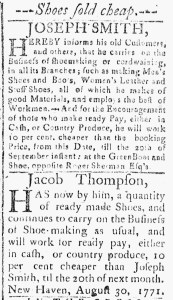What was advertised in a colonial American newspaper 250 years ago today?

“Shoes sold cheap.”
Joseph Smith and Jacob Thompson competed for customers. Both placed advertisements in the September 6, 1771, edition of the Connecticut Journal to promote the shoes they made and sold in New Haven. Smith’s notice appeared first, informing prospective customers that “he carries on the Business of shoemaking or cordwaining, in all its Branches” at his shop located at “the Green Boot and Shoe.” He used “good Materials” and hired “the best of Workmen.” In case that was not enough to attract the attention of local consumers, Smith also described a limited-time offer for those ready to pay (or barter for “Country Produce”) immediately rather than purchase their shoes and boots on credit. Until September 20, he would “work 10 per cent. cheaper than the booking price.” Customers could take advantage of this bargain, but only if they acted quickly.
Thompson’s advertisement ran immediately below Smith’s notice. He declared that he “continues to carry on the Business of Shoe-making as usual” and already had “a quantity of ready made Shoes” in stock. Rather than allow Smith to get the upper hand by setting lower prices, Thompson made an offer of his own. For customers prepared to pay (or, again, barter) rather than buy on credit, he sold his shoes “10 per cent cheaper than Joseph Smith.” This offer also concluded on September 20. Only on rare occasions did advertisers mention competitors by name in eighteenth-century America, making Thompson’s notice exceptional. Merchants, shopkeepers, and artisans frequently proclaimed that they had the lowest prices in town (or sometimes the entire colony). Some offered to match the prices of their competitors, but they usually did not seek to undercut other purveyors of goods and services as blatantly as Thompson attempted to do with Smith.
The publication history of these advertisements added another layer to the competition. Smith first inserted his notice in the Connecticut Journal on August 23, giving prospective customers four weeks to respond to his offer. The following week, Thompson placed his advertisement as a response, but the two notices appeared on different pages. On September 6, the printers decided to place the two advertisements together and added a headline that trumpeted, “Shoes sold cheap.” Neither Smith nor Thompson had previously included that headline in their advertisements. A line separated it from Smith’s advertisement, making clear that the headline was an addition rather than part of either notice. Why did the printers intervene? Were they having some fun with the competition between two local shoemakers? Whatever their intention, the new headline enhanced the advertisements, calling greater attention to them and benefitting consumers with cash (or country produce) on hand to respond to the limited-time offer.
